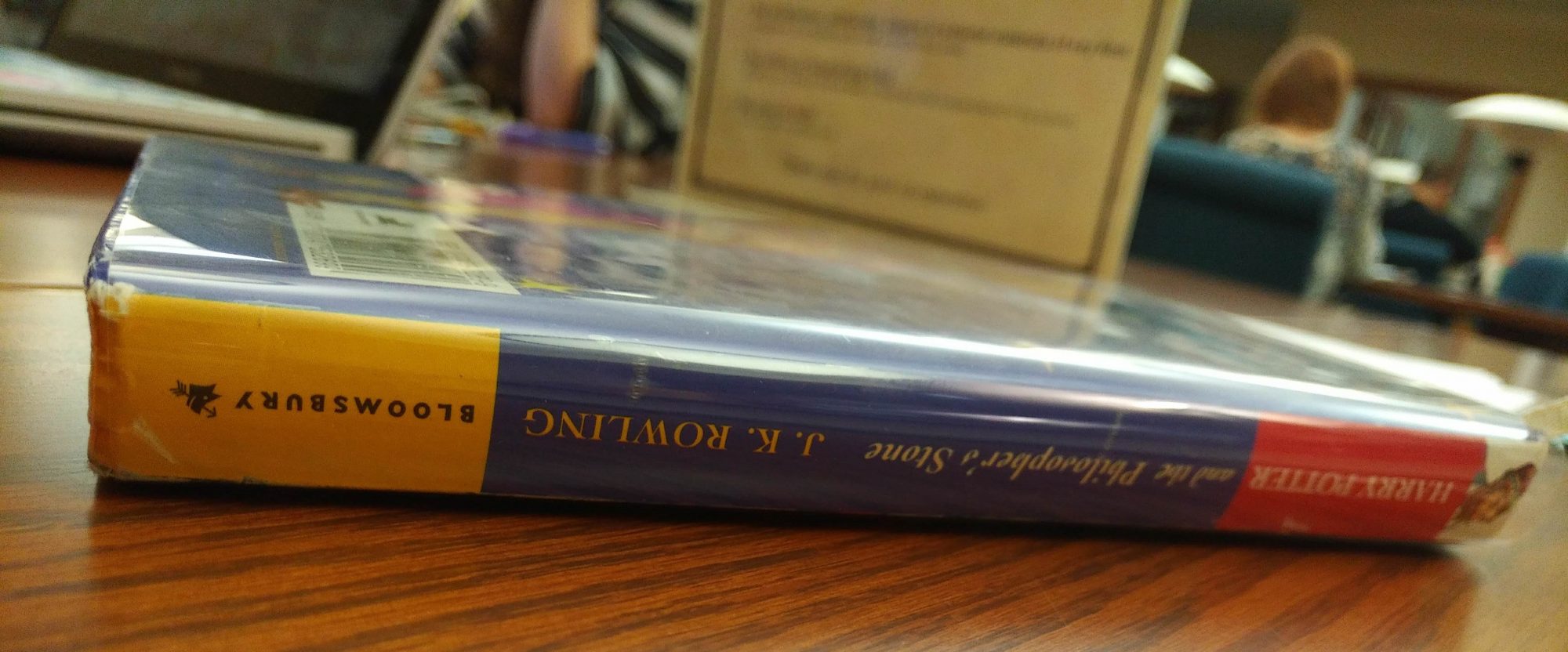
The British and US editions are strikingly different from each other— the title and the text itself were altered to better suit American audiences who the US publisher, Scholastics Books, felt would not understand the meaning of certain “British” words and phrases. Therefore, Americans know The Philosopher’s Stone as The Sorcerer’s Stone, something that Rowling regrets allowing the publishers to do but nonetheless has continued in the movies and subsequent reprintings. The size of the books is probably the first format difference that is noticeable, with the US edition having a larger width and height than its British counterpart. Another interesting note is the typeface used for the title and author on the cover. The American cover uses a type that carries later into marketing for the movie, namely the “Harry Potter” title used in films and marketing, whereas the original British text uses a simple serif font for the title. The title on the American edition is part of the design, forming part of the archway in the illustration, whereas the British design separated illustration from text to appear more conservative and simpler in design.


On the back of the book, we see some of the first differences in the layout and display of content between the two books. The UK edition contains a short synopsis, focusing on how Harry thinks he’s normal but finds out he is a wizard, listing a few strange things like owls, Hogwarts, Quidditch, and duelling to peak the reader’s attention. It then lists “Acclaim for harry potter and the Philosophers Stone” in the form of three quotations from individuals, strangely including David Morton an executive at an accounting firm who is today a doctor for the NHS, Fiona Waters of Fiona Waters Associates, now Waters Economics, and Lindsey Fraser of Book Trust Scotland, who wrote the first review of Harry Potter and the Philosophers Stone in The Scotsman the day after the publication of this first print. The American edition, which was published in September 1998 (one year and two months after Bloomsbury’s UK print), contains just one brief quotation from “The Guardian, London” which begins with an emphasised “Harry Potter” and compares the character to Charlie from Charlie and the Chocolate factory, a comparison one of the quotations found on the British version also notes. Another difference on the back is the absence of the publishers mark on the back of the American Edition. The British Edition has the Bloomsbury logo on the back with their wordmark on the spine, whereas the US edition has the Authur A. Levine Books/ Scholastics Pres mark solely on the spine.

Finishing off the cover, the American version uses the inside of the dust cover to place the synopsis, as well as the back inside flap for a small blurb about Rowling. Above is an image of the inside flap, and in reading it one can see that it is more detailed than its British counterpart, hinting at key plot points of the dragons egg, invisibility cloak, and harry as a Quidditch star, and is about three times the length.


Another thing to note about the American and British texts is that the British text keeps the same text style throughout, and doesn’t change typeface or add graphic elements to mimic handwriting, something which the US edition does frequently. Clicking on the two images above the difference is evidenced in the appearance of Professor McGonagall’s name in the letter from her to Harry


The text changes are not solely cosmetic or meant to replace a single word which Americans might not understand (for example, “Comprehensive” is replaced by “public school”, “motorbike” with “motorcycle”, “Video Recorder” with “VCR” etc). In the sorting ceremony, a character is actually added in, and that character is identified as a black boy, something absent in the British text. if you click on the British edition’s image, you can see about halfway down the page it reads “And now there were only three people left to be sorted. ‘Turpin, Lisa,’ became a Ravenclaw and then it was Ron’s turn.” A Zabini, Blaise is sorted shortly afterword rounding up the last three. The American version, however, differs— it says, “And now there were only three people left to be sorted. ‘Thomas, Dean,’ a black boy even taller than Ron, joined Harry at the Gryffindor table. ‘Turpin, Lisa,’ becomes a Ravenclaw and then its Ron’s turn” A Zabini, Blaise similarly then is sorted making the total actually 4. Dean Tomas, a character who later features in the film and books, is added in solely in the US edition and the text isn’t even altered to reflect the addition, still starting by letting the reader know three people need to be sorted. The fact that it describes Thomas as a black boy is interesting in an American context, and could possibly have been added to allow African American children to see themselves at Hogwarts. The question then is why was it added so sloppily and why did it not get put in the British Edition?
